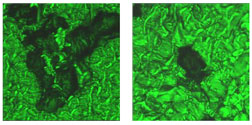Far above the heads of Earthlings, arrays of single-cell creatures embedded in nanostructures ride on the International Space Station (courtesy of Sandia National Laboratories and the University of New Mexico, NASA, and the U.S. Air Force) to test whether nanostructures whose formations were directed by yeast and other single cells can create more secure homes for their occupants—even in the vacuum and radiation of outer space—than those created by more standard chemical procedures.
Cheap, tiny, and very lightweight sensors of chemical or biological agents could be made from long-lived cells that require no upkeep, yet sense and then communicate effectively with each other and their external environment. Groups of such long-lived cells may also serve as models to investigate how tuberculosis bacteria survive long periods of dormancy within human bodies. En masse, they also may be used to generate signals to repel harmful bacteria from the surfaces of surgical tools such as catheters. Finally, the method also offers a simple method for genetic modification of cells.
In a paper in the July 21 issue of Science, a team of researchers from Sandia National Laboratory, Los Alamos National Laboratory, and the University of New Mexico demonstrated that common yeast cells (as well as bacterial and some mammalian cells) customize the construction of nanocompartments built for them. These nanocompartments—imagine a kind of tiny apartment house—form when single cells are added to a visually clear, aqueous solution of silica and phospholipids, and the slurry is then dried on a surface. (Phospholipids are two-sided molecules that make up cell membranes.) The cells have emerged still viable after examination in electron microscopes and after x-ray exposure at the X-ray Operations and Research 1-BM-C beamline at the U.S. Department of Energy’s Advanced Photon Source at Argonne National Laboratory.
Read the complete Sandia National Laboratory press release.
Contact: C. J. Brinker (University of New Mexico), [email protected]
See : Helen K. Baca, Carlee Ashley, Eric Carnes, Deanna Lopez, Jeb Flemming, Darren Dunphy, Seema Singh, Zhu Chen, Nanguo Liu, Hongyou Fan, Gabriel P. López, Susan M. Brozik, Margaret Werner-Washburne, C. Jeffrey Brinker, "Cell-Directed Assembly of Lipid-Silica Nanostructures Providing Extended Cell Viability," Science 313 (5785), 337-341 (21 July 2006) . DOI: 10.1126/science.1126590
This work was supported through the National Defense Science and Engineering Graduate Fellowship Program sponsored by the Air Force Office of Scientific Research (AFOSR); AFOSR (FA9550-04-1-0087); the Sandia National Laboratories Laboratory Directed Research and Development program; the Army Research Office (DAAD 19-03-1-227); and the NIH Nanomedicine Center Program (#206-00139-06). Use of the Advanced Photon Source was supported by the U.S. Department of Energy, Office of Science, Office of Basic Energy Sciences, under Contract No. W-31-109-ENG-38. Sandia is a multiprogram laboratory operated by Sandia Corporation, a Lockheed Martin Company, for the U.S. Department of Energy's National Nuclear Security Administration under Contract DE-AC04-94AL85000.

